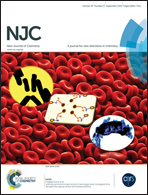Evidence for hydrogen-bonded ammonia wire influencing the ESMPT process of the 7-hydroxy-4-methylcoumarin·(NH3)3 cluster
Abstract
The excited-state multiple proton transfer (ESMPT) reaction has been investigated for tautomerization of the 7-hydroxy-4-methylcoumarin·(NH3)3 (7H4MC·(NH3)3) cluster by means of time-dependent density functional theory. In the 7H4MC·(NH3)3 cluster, our results have demonstrated that four intermolecular hydrogen bonds are strengthened in the first excited state upon photoexcitation. This mechanism can remarkably facilitate the releasing of the proton from the phenolic group of the 7H4MC moiety to the hydrogen-bonded ammonia wire (NH3⋯NH3⋯NH3). Subsequently, an intermediate transition conformer (A·(NH3)3H+) appears on the excited-state proton-transfer energy curve. In the A·(NH3)3H+ conformer, the intramolecular charge transfer process is revealed due to the proton motion. This process is able to effectively trigger the subsequent ESMPT reaction. Therefore, the different types of excited-state hydrogen-bonded dynamics mechanisms orderly provide two driving forces for the ESMPT reaction in the 7H4MC·(NH3)3 cluster. In addition, the mechanism of the ESMPT processes in the 7H4MC molecule along different kinds of hydrogen-bonded wires (ammonia and water) has been elucidated, and the internal property of transformation is discussed in detail.


 Please wait while we load your content...
Please wait while we load your content...